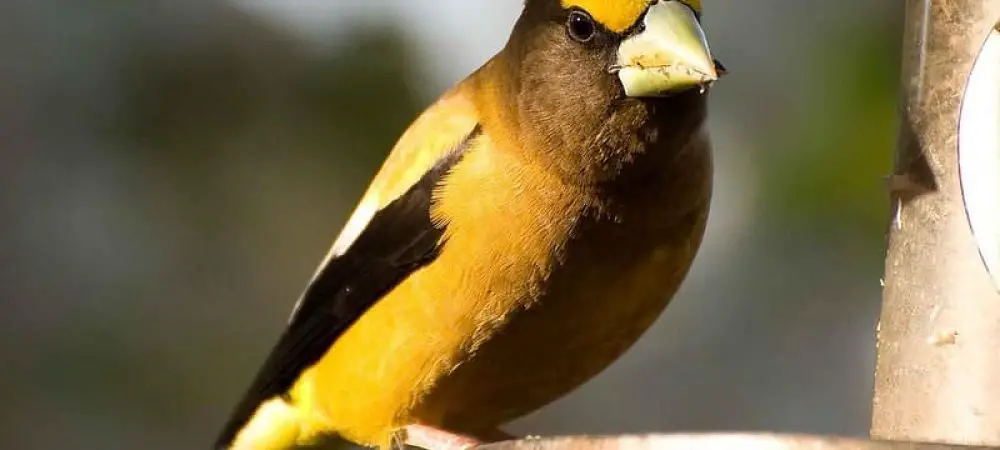
In the state of Arizona you may encounter twelve different species of finches.
Table of Contents
ToggleThese finches are:
- House Finch
- Lesser Goldfinch
- Cassin’s Finch
- American Goldfinch
- Lawrence’s Goldfinch
- Purple Finch
- Black Rosy-Finch
- Gray-crowned Rosy-Finch
- Red Crossbill
- Evening Grosbeak
- Pine Grosbeak
- Pine Siskin
Want to learn more? This book on everything to do with Finches is a fantastic read!
Arizona is a southwestern state in the United States, widely renowned for the iconic Grand Canyon.
Arizona is also considered one of the Mountain States and is praised for its incredible variety of natural landmarks like Flagstaff, Saguaro National Park, and the Sonoran Desert landscape.
Arizona’s geographic location influences its fascinating climates that include semiarid, arid, and humid.
This diverse range of climates offers a wonderful home to all types of birdlife.
It may come as no surprise that Arizona is home to 31 state parks, and home to a magnificent 12 species of finches!
While you are most likely to observe the House Finch, you may only occasionally see the Pine Siskin. Below, you’ll find the fascinating qualities of each finch species!
Want to attract finches? Take a look at our article!
What Finches can be seen in Arizona?
Table of Contents
1. House Finch
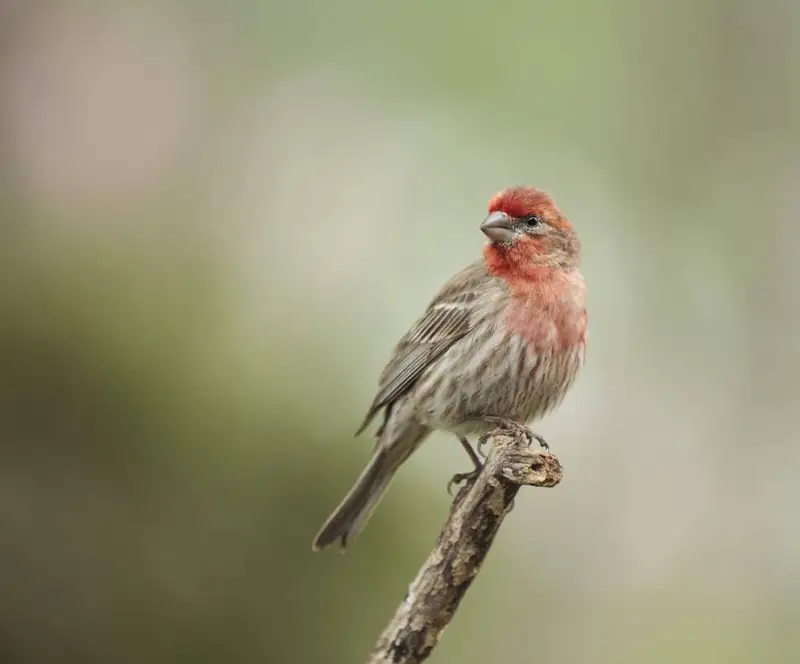
William Whitehead, XC629127. Accessible at www.xeno-canto.org/629127.
Fun Facts:
- A finch’s diet is dependent on the type of beak they have. House Finches have a seed feeding beak as seeds are their main source of food. The most popular seed for them is the black oil sunflower seed. They also eat certain types of flower buds and fruits, these incluce cherries and thistle.
- House Finches are only very small birds with a small weight range. They range from 16-27g and have only a tiny wingspan of 20-25cm.
House Finches are a small finch species that have notably long heads and large bills.
Male finches actually come in a variety of shades, some of them can be an orangish or yellowish color. For the most part, they have red heads and upperparts with gray napes, backs, and wings.
You’ll also notice that they have a bit of side streaking. Female House Finches are a pale, gray-brown color all over.
House Finches are very common birds throughout many habitats in Arizona. These finches abundantly take habitat in the Sonoran Desert along washes and mountain slopes.
They have also been readily seen in parks and cities as they visit backyard bird feeders.
Interestingly, the breeding season near the Sonoran Desert region is relatively long, taking place from early spring and sometimes lasting to very late autumn well into October.
House Finches are known for their sharp, in-flight ‘cheep’ call that can sometimes even be heard while they are perched.
2. Purple Finch
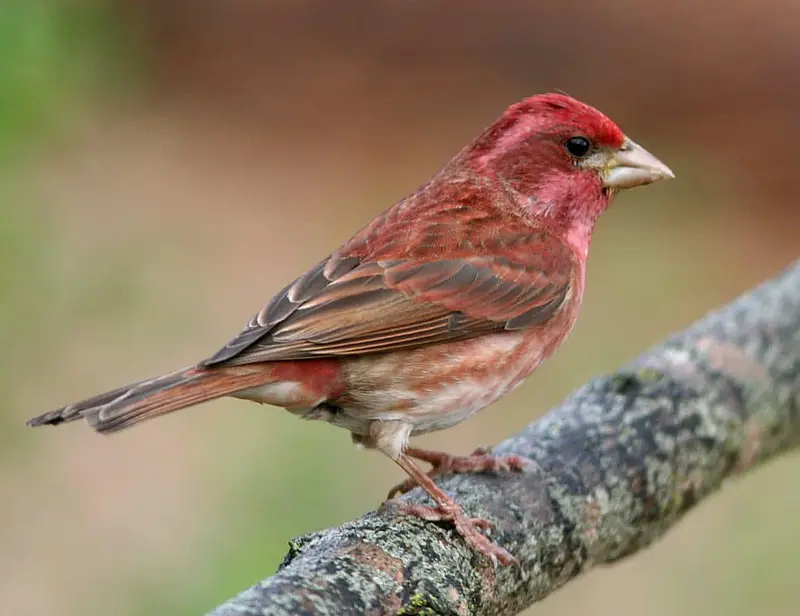
Peter Ward and Ken Hall, XC598463. Accessible at www.xeno-canto.org/598463.
Fun Facts:
- These birds have bills that are designed for breaking different seeds open. Their favourite seeds include black oil sunflower seeds and safflower seeds. They also enjoy eating nectar and occasionally consume flower buds.
- Purple Finches weigh just slightly more than House Finches at 18-32g. They also have very small wingspans which range from 22-26cm.
Purple Finches are a medium-sized species known for their striking raspberry red colored feathers.
The mature males of this species display a tie-dyed pattern on their crest, breast, back, and rump.
However, adult females and juveniles are more of a light brown color above with white underbellies.
These finches are casual visitors to Arizona in the autumn and winter months.
They prefer to breed and take habitat in coniferous or mixed deciduous forests.
They have also been observed in the winter months, taking habitat in coniferous woods and suburban backyards.
Purple finches are also quite noisy birds, and have been heard in forests as they forage in high trees.
The adult finches of this species are known for their soft ‘tik’ sound while they are flying. The juvenile finches, however, are known for their ‘peewee’ call.
3. American Goldfinch
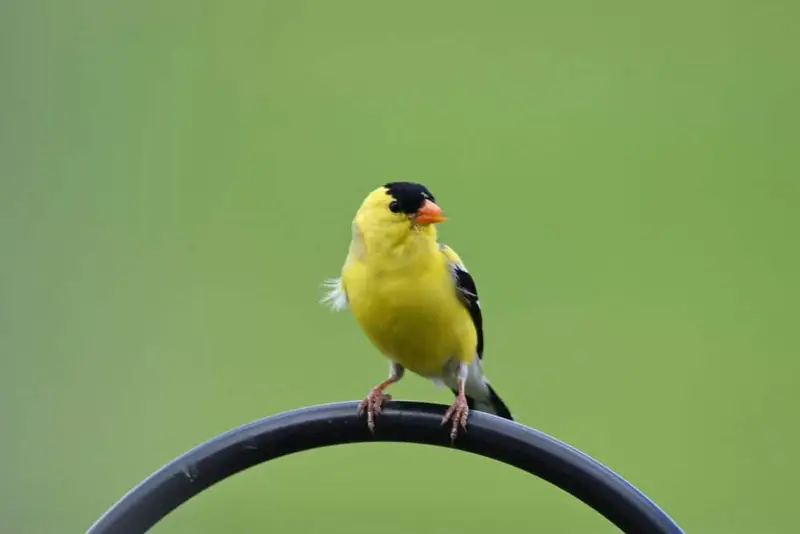
Russ Wigh, XC610948. Accessible at www.xeno-canto.org/610948.
Fun Facts:
- American Goldfinches have a beak designed for eating small seeds. Nyjer seeds being a favourite of theirs. They rarely eat anything outside of the seed family.
- These finches are slightly smaller than the other finches that we’ve looked at, weighing only 11-20g. They also have a very tiny wingspan which measure 19-22cm.
American Goldfinches are quite tiny birds with sharp bills. It’s important to note that the color of these birds very much depends on the seasons.
For the most part, mature males are bright yellow with black wings and foreheads. Mature females have faded yellow underparts but are olive green above.
The females are also known for the bars detailing their wings. However, during the winter months females are an overall brown color.
These finches are quite widespread throughout the state of Arizona. They are primarily observed during the summer in regions with cottonwood, willows, and live oaks.
During fall months, they can even be seen in high mountains in aspens. During the winter, they are primarily seen near the Sonoran Desert.
The breeding season in Arizona is quite irregular as they nest on tree limbs above ground level. These finches are commonly known for their ‘po-ta-to-chip’ call.
4. Pine Siskin
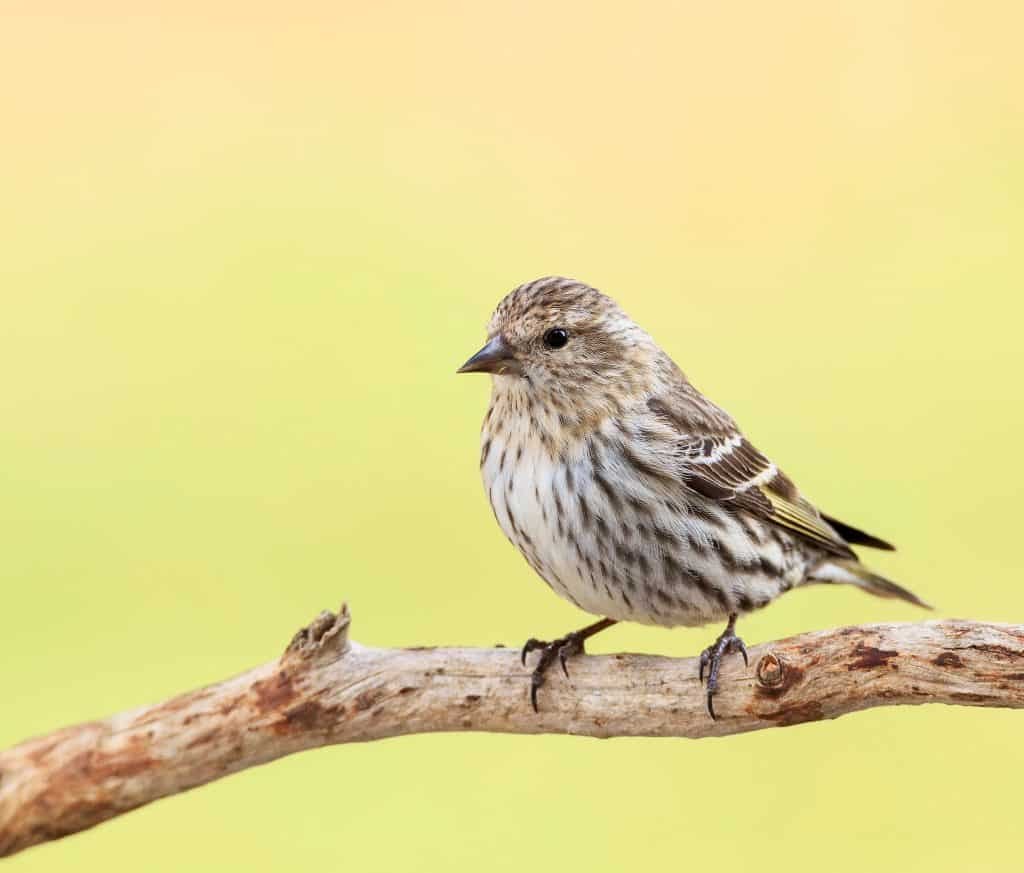
William Whitehead, XC595659. Accessible at www.xeno-canto.org/595659.
Fun Facts:
- These birds have beaks designed for eating seeds and, as the name suggests, they mostly eat seeds from the pine family. As well as seeds, they have also been known to forage for small insects, these insects are usually aphids.
- Pine Siskins are very similar in size to the American Goldfinch, weighing in at a range of 12-18g. Like other finches, they also have small wingspans of 18-22cm.
Pine Siskins are small birds with notably sharp beaks, short tails, and broad wings.
Though Pine Siskins are streaked brown, they have subtle yellow detailing on their tails and wings. This species is quite erratic, though you’ll most likely see these finches near evergreen and deciduous forests.
However, Pine Siskins are known to adapt depending on their food supply and have been spotted foraging in weedy fields, thickets, backyards, and gardens.
Not only does food supply influence their habitat, but also their breeding season. Some birds breed during the spring and summer, while others breed during the cold winter months.
Pine Siskins are sometimes seen in flocks with other birds, so keep an eye out! You’ll be able to identify these birds due to their social and vocal behaviors.
They have a distinctive buzzing ‘bzzzzzt’ sound that mimics the sound of a zipper.
5. Grey-Crowned Finch
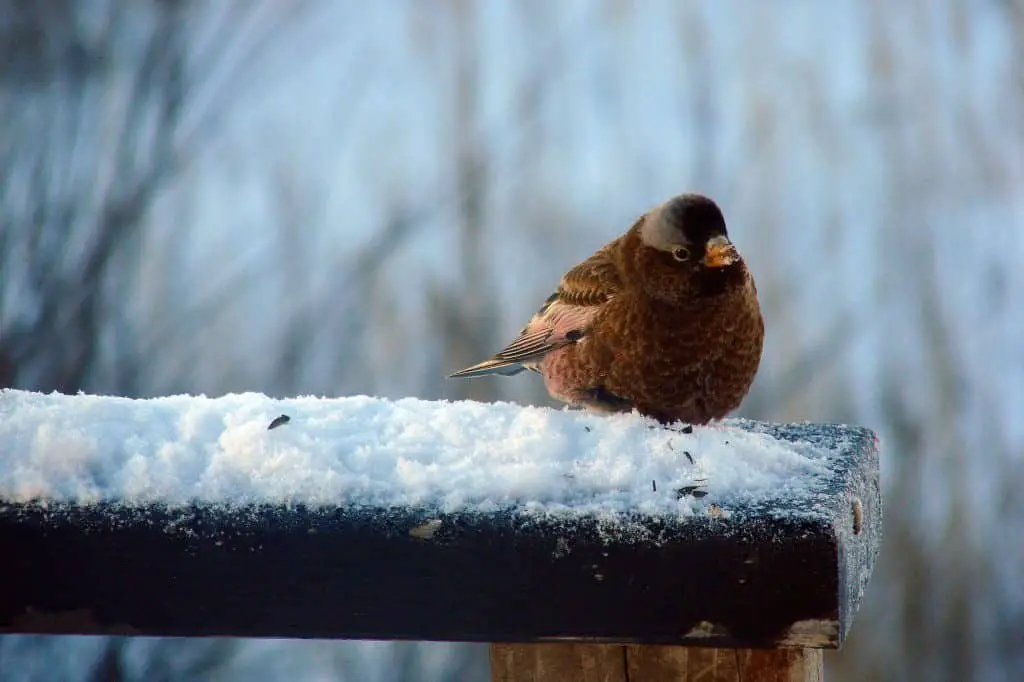
Andrew Spencer, XC143945. Accessible at www.xeno-canto.org/143945.
Fun Facts:
- These birds will primarily eat seeds but have also been known to eat insects throughout the summer.
- These finches are slightly larger than others, they can weigh from 20-60g.
Gray-crowned Rosy Finches are medium-sized finches known for being the most widespread Rosy-Finch.
The adults have chocolate-colored bodies with pink highlights on their wings, tails, and bellies.
A number of these finches also have gray on the backs of their heads or an entirely gray cheek. The juvenile finches, however, are a much duller version of the adults.
These finches can most readily be spotted during the spring and summer months as they breed at very high elevations.
During winter, however, you will spot them at low elevations, even foraging on alpine snowfields. Overall, Gray-crowned Rosy-Finches take habitat in a variety of areas such as high mountains, cliffs, ice fields, and meadows.
At times during the winter, they can be seen in Arizona’s suburban settings.
They have been seen traveling in mixed flocks of other finches during winter months. You can distinguish Gray-crowned Rosy-Finches by their sharp ‘chew’ call and their general chirping and squawking sounds
6. Black Rosy Finch
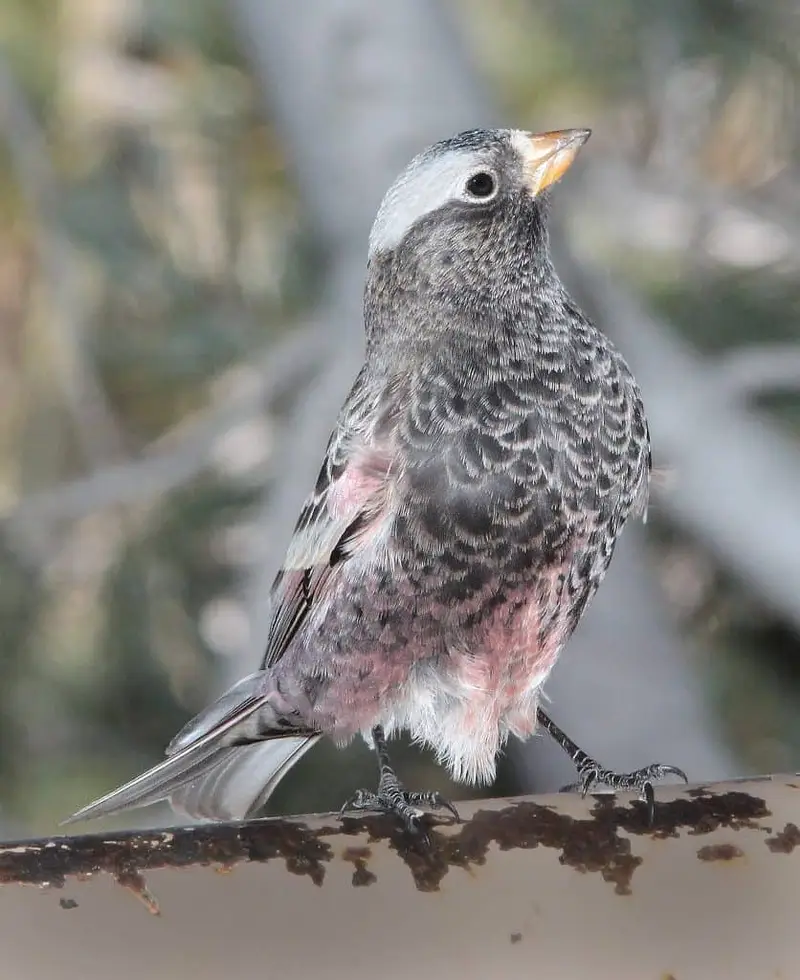
Andrew Spencer, XC143904. Accessible at www.xeno-canto.org/143904.
Fun Facts:
- These birds will eat seeds year-round but will sometimes eat insects during the summer when they are more readily available.
- These finches are medium sized and have a weight range of 20-32g.
Black Rosy-Finches are medium-sized finches that are highly admired for their dark colored bodies with pink highlighting on their wings and tails.
Take note, however, that only the breeding finches have such distinct colors, and non-breeding birds are much paler.
Though these finches are not exactly widespread across Arizona, they are an expected species in the state. They prefer to take habitat and breed in alpine areas, in close proximity to rock piles and cliffs.
They prefer to spend the winter months near Arizona’s mountain meadows, high deserts, valleys, and plains.
Black Rosy-Finches can typically be seen at high elevations in open areas near cliffs and around snowmelt. You can usually find them during the winter at lower elevations in close proximity to bird feeders.
You can also find them in large flocks with other similar species. You’ll identify Black-Rosy Finches due to their distinct buzzy ‘chew’ and their high octave whining call.
7. Cassin’s Finch
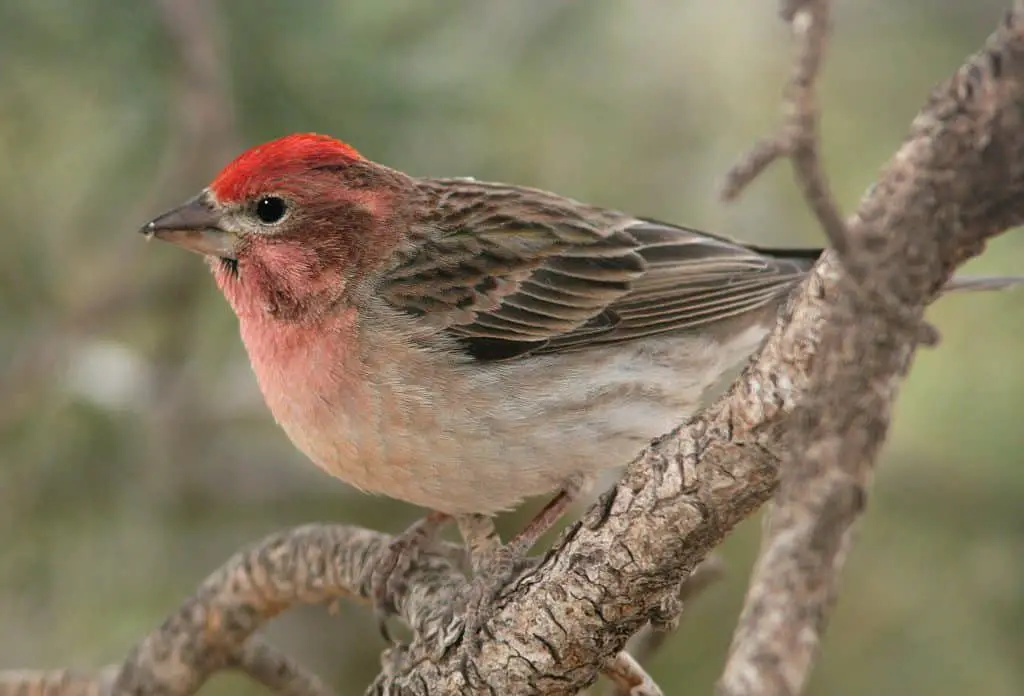
Richard E. Webster, XC621695. Accessible at www.xeno-canto.org/621695.
Fun Facts:
- These birds primarily feed on seeds, however they do eat insects when they are available.
- These finches are slightly larger than the others, weighing in at 24-34g.
Cassin’s Finches are a small species of finch with peaked heads and somewhat long bills.
The adult males are a rosy pink color with a vibrant red patch on their heads. Female and juvenile finches, however, are overall brown and white with dark streaks detailing their chests and underbellies.
These particular finches are quite common and widespread throughout Arizona, though their overall population is slightly declining.
Cassin’s Finches typically breed near mountains, and their breeding season depends upon adequate food supply although they have been known to breed mostly during spring months.
These birds prefer to take habitat in evergreen forests high in mountainous areas, though, they live at lower elevations during the winter.
Cassin’s Finches have also been observed visiting backyard bird feeders.
You have a chance at spotting them while building their nests in spring, as the females collect twigs and weeds for nest materials. You’ll easily identify Cassin’s Finches by their beautiful ‘tulip’ call.
8. Red Crossbill
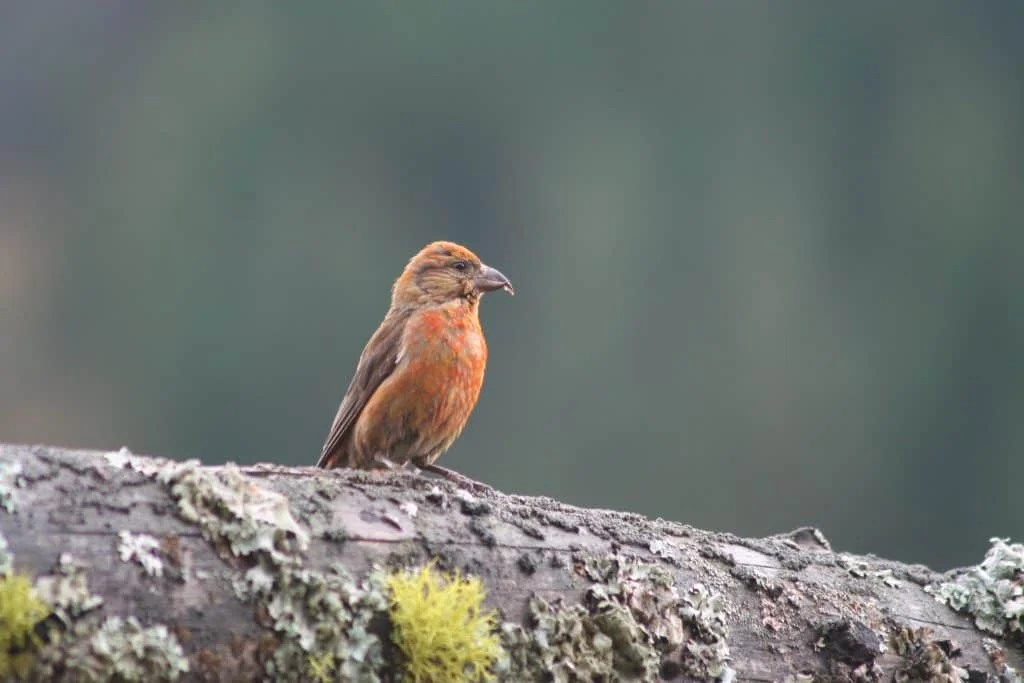
Stanislas Wroza, XC626649. Accessible at www.xeno-canto.org/626649.
Fun Facts:
- The Red Crossbills mostly feed on seeds, particularly pine seeds. During the summer they will also sometimes eat insects.
- Due to their varied and unstudied sizes, there is no average weight range for this bird.
Red Crossbills are a small species of finch, though they have quite large heads and a unique crossed bill.
Mature male crossbills are generally a pastel, reddish-orange all over with either gray or brown highlights.
Females, on the other hand, are a light olive color.
The immature crossbills have an appearance similar to the females, though they are a more faded color and have more of a streaked pattern.
In Arizona, Red Crossbills are known to take habitat in a variety of environments with abundant ponderosa pine.
These finches are quite nomadic and breed at irregular times during the year.
They tend to breed whenever there is a plentiful cone supply present. You have a chance of spotting these birds due to their social nature of traveling in small flocks.
However, there are some solitary birds that have been spotted in towns. Adult male Red Crossbills are known for their trills and chirps that resemble ‘chee-chee”.
9. Lesser Goldfinch
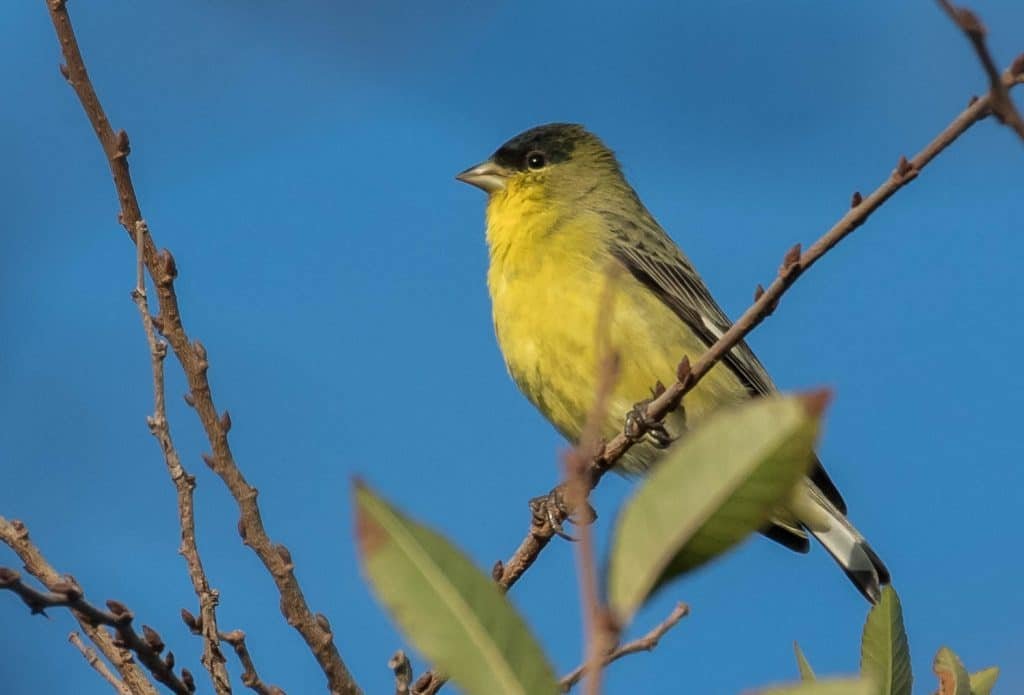
Paul Marvin, XC549158. Accessible at www.xeno-canto.org/549158.
Fun Facts:
- These finches mostly eat seeds however they will also consume fruit from time to time, such as elderberries. In summer they will also eat certain types of flowers.
- These finches are the smallest of the species that we have previously looked at, they weigh only 8-11.5g with a wingspan of 15-20cm.
Lesser Goldfinches are classified as small finches, widely recognized for their petite heads and sharp, dark-colored beaks.
Mature male finches usually have either black or green backs with black caps, while the females are olive-colored with yellow underbellies.
Lesser Goldfinches prefer to live in weedy fields, treetops, and open areas. They have also been known to live in mountain canyons and desert oases if there is an adequate food supply.
They are actually quite common in well-vegetated canyons in the Sonoran Desert. In Arizona, these finches usually breed between April and July where they nest in a variety of trees, and can be spotted near open waters.
These finches are admired for their beautiful melody of twittering notes.
10. Evening Grosbeak
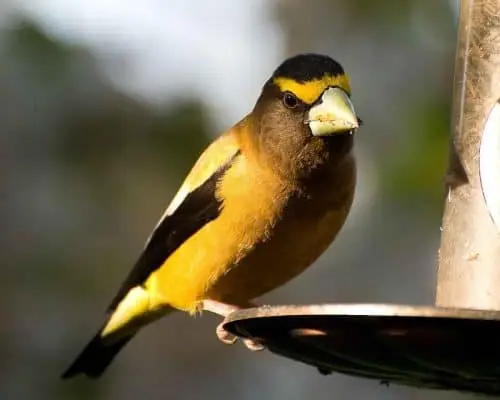
Doug Hynes, XC612610. Accessible at www.xeno-canto.org/612610.
Evening Grosbeaks are larger birds widely recognized due to their thick build and tough beaks.
The mature male grosbeaks have a brilliant black color on their heads that turns into bright yellow feathers on their underbellies.
They have black wings that are detailed with white feathers. However, the females and immatures are an overall gray with slight white wing patterns.
These finches are known to wander in the winter months and have been observed in Arizona. They prefer to take habitat in conifer forests and fruiting shrubs.
These grosbeaks are known to breed during the spring in coniferous and mixed forests with pines in western mountains.
During their winter travels, they have also been seen in deciduous groves in woodlands and country areas. Evening Grosbeaks can be recognized due to their rising and falling ‘chee-er’ call.
11. Lawrence's Goldfinch
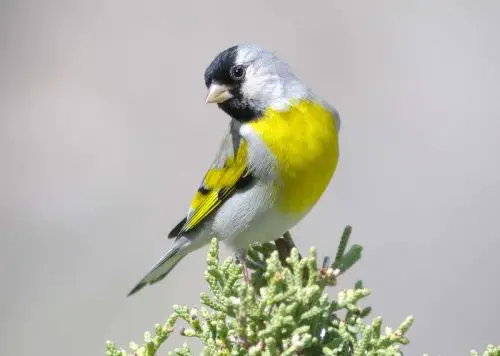
Paul Marvin, XC566765. Accessible at www.xeno-canto.org/566765.
Lawrence’s Goldfinches are small birds that are praised for their unique, gray bodies. The males have dark black foreheads and throats, with distinct black and yellow patterned wings, and a yellow breast.
The females have similar patterns, although they are a paler color than males.
These goldfinches have a somewhat sporadic distribution through Arizona, seen mostly near the Sonoran Desert regions, particularly in southern Arizona.
You’ll most likely see these birds from October to April, though you may occasionally see non-breeding birds in the summer months.
Lawrence’s Goldfinches tend to take habitat in open grassy woodlands and near very dry desert areas.
Their nests can be recognized as a small open cup made from grass, flower heads, feathers, and even animal hair. You’ll recognize these finches by its unique combination of melodies and scratchy notes.
12. Pine Grosbeak
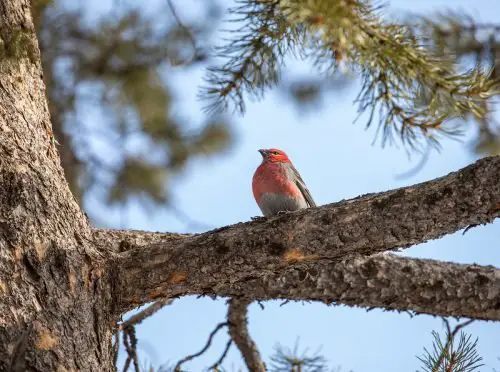
Teus Luijendijk, XC623573. Accessible at www.xeno-canto.org/623573.
Pine Grosbeaks are large, heavy finches with striking, vibrant patterns.
The mature male finches are an overall pink color with faded gray highlights, and two white wing bars. The juveniles are a more faded color, but with similar patterns.
They have gray bodies with yellow or orange detailing on their head and rumps. These finches prefer to take habitat in conifers during the warmer months, but tend to flock to other trees during the winter.
You’re most likely to observe these birds during the summer in open spruce and pine forests warbling at treetops.
Pine Grosbeaks breed in the spring and summer months, usually in open coniferous forests with spruce and fir.
It’s worth mentioning that you have a chance at spotting them in the winter near fruit-bearing trees, as flocks have been known to stay near a tree until all of the fruit is eaten. You’ll recognize them by their 3-note whistle that sounds like ‘tee-tee-tew’.

More Articles.
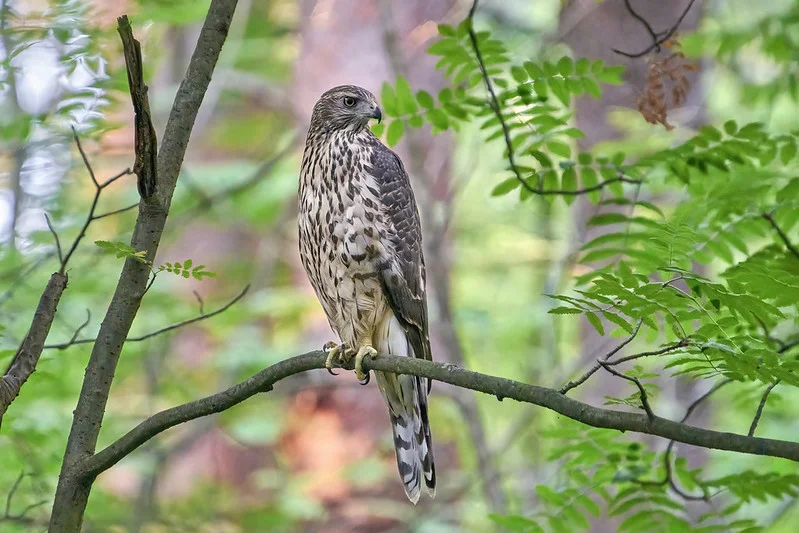
What Hawks can you see in Germany? (3 Species with Pictures & Sounds)
What Hawks can you see in Germany? There are 3 different species of Hawks that
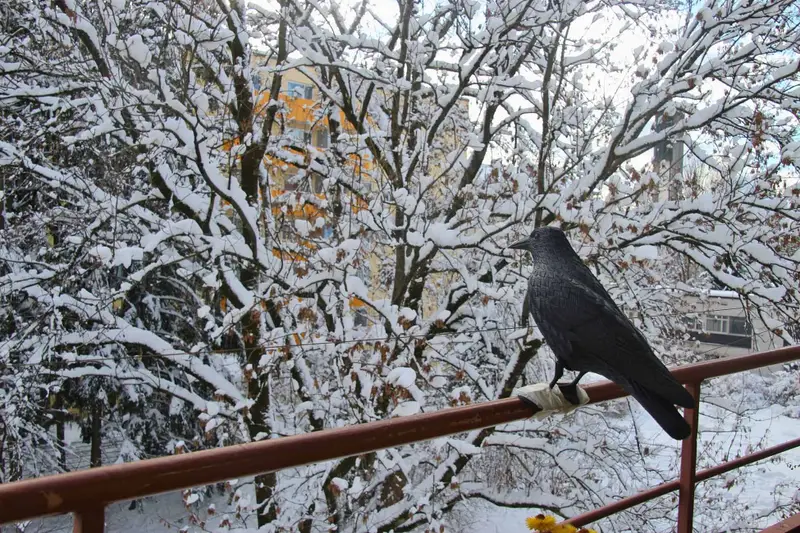
How to Attract Birds to a Window?
All birds can be attracted to a window feeder. Some will require bright colors to
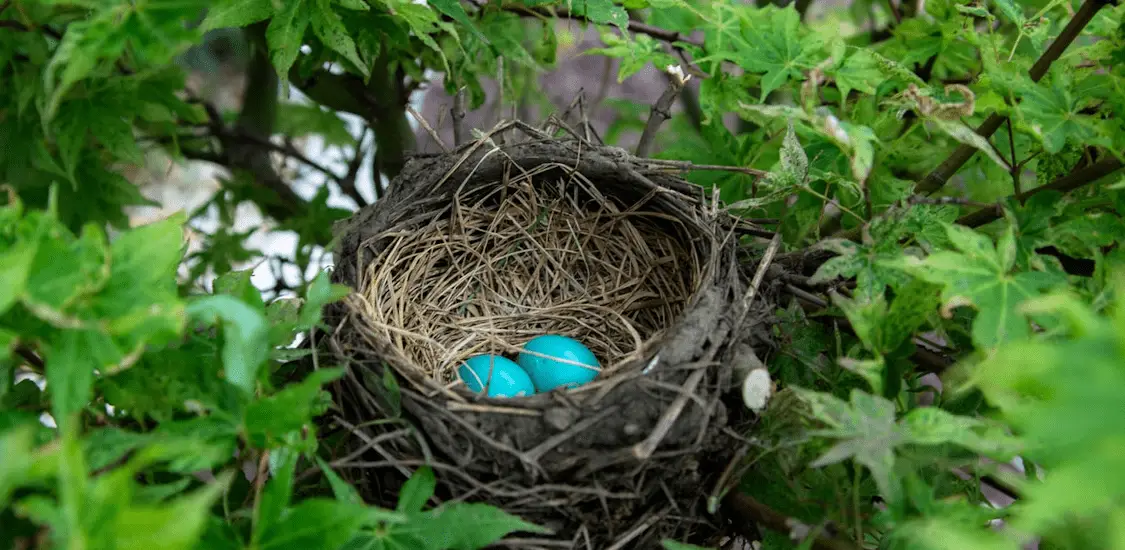
How to safely remove a birds nests?
First ensure that it is legal to remove the birds nests. An empty and abandoned

About Us
We are avid bird-watchers who recently retired, allowing us more time to travel the world. Fortunately, we have managed to visit numerous countries around Europe, Asia, and America. Watching and photographing birds has been a passion for many years and we are making the most of the extra time on our hands!
